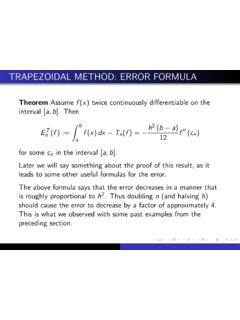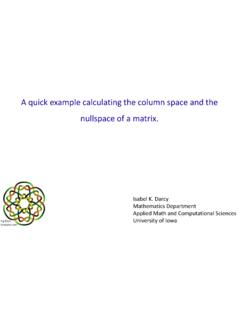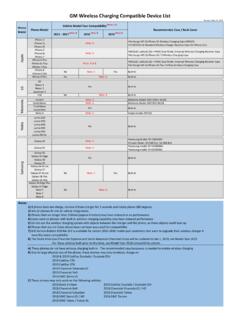Transcription of NUMERICAL STABILITY; IMPLICIT METHODS
1 NUMERICAL stability ; IMPLICIT METHODS . When solving the initial value problem Y 0 (x) = f (x, Y (x)), x0 x b Y (x0 ) = Y0. we know that small changes in the initial data Y0 will result in small changes in the solution of the differential equation. More precisely, consider the perturbed problem Y 0 (x) = f (x, Y (x)), x0 x b Y (x0 ) = Y0 + . Then assuming f (x, z) and f (x, z)/ z are continuous for x0 x b, < z < , we have max |Y (x) Y (x)| c | |. x0 x b for some constant c > 0. We would like our NUMERICAL METHODS to have a similar property. Consider the Euler method yn+1 = yn + hf (xn , yn ) , n = 0, 1, .. y0 = Y0. and then consider the perturbed problem . yn+1 = yn + hf (xn , yn ) , n = 0, 1, .. y0 = Y0 + . We can show the following: max |yn yn | cb | |. x0 xn b for some constant cb > 0 and for all sufficiently small values of the stepsize h.
2 This implies that Euler's method is stable, and in the same manner as was true for the original differential equation problem. The general idea of stability for a NUMERICAL method is essentially that given above for Eulers's method. There is a general theory for NUMERICAL METHODS for solving the initial value problem Y 0 (x) = f (x, Y (x)), x0 x b Y (x0 ) = Y0. If the truncation error in a NUMERICAL method has order 2 or greater, then the NUMERICAL method is stable if and only if it is a convergent NUMERICAL method. Note that Euler's method has a truncation error of order 2. The NUMERICAL METHODS studied in this chapter are both stable and convergent. All of these general results on stability and convergence are valid if the stepsize h is sufficiently small. What is meant by this? Rather than studying this for a general problem, we restrict our interest to the model problem Y 0 (x) = Y (x), x 0, Y (0) = 1.
3 The analysis for this problem is generally applicable to the more general differential equation problem. The true solution is Y (x) = e x . When < 0 or is complex with Re( ) < 0, we have Y (x) 0 as x . We would like the same to be true for the NUMERICAL solution of the model problem. We begin by studying Euler's method applied to the model problem. EULER'S METHOD AND THE MODEL PROBLEM. Apply Euler's method to the model problem. yn+1 = yn + h yn = (1 + h ) yn , n = 0, 1, .. with y0 = 1. By induction, yn = (1 + h )n , n 0. The NUMERICAL solution yn 0 as n if and only if |1 + h | < 1. In the case is real and negative, this is equivalent to 2. 2 < h < 0, or h <.. If | | is quite large, then h must be correspondingly small. Usually the truncation error does not require such a small value of h; it is needed only for stability . NUMERICAL EXAMPLE.
4 Consider the problem Y 0 (x) = Y (x) + (1 ) cos(x) (1 + ) sin(x). with Y (0) = 1. The true solution is Y (x) = sin(x) + cos(x). We use Euler's method and give NUMERICAL results for varying and h 2. are given. The truncation error Tn+1 = h2 Y 00 ( n ) does not depend on , but the NUMERICAL solution does. x Error: Error: Error: h = h = h = 1 1 1 2 3. 3 2 3 4. 5 1 2 3. 10 1 1 3 4. 3 + 2 3 4. 5 + 4 3 4. 50 1 + 0 + 3 4. 3 + 6 + 15 5. 5 + 11 + 27 5. ABSOLUTE stability . The set of values of h for which the NUMERICAL solution yn 0 as n is called the region of absolute stability of the NUMERICAL method. We allow to be complex, restricting it with Re( ) < 0. With Euler's method, this region is the set of all complex numbers z = h for which |1 + z| < 1. or equivalently, |z ( 1)| < 1. This is a circle of radius one in the complex plane, centered at the complex number 1 + 0 i.
5 If a NUMERICAL method has no restrictions on in order to have yn 0 as n , we say the NUMERICAL method is A-stable. THE BACKWARD EULER METHOD. Expand the function Y (x) as a linear Taylor polynomial about xn+1 : 1. Y (x) = Y (xn+1 ) + (x xn+1 ) Y 0 (xn+1 ) + (x xn+1 )2 Y 00 ( n ). 2. with n between x and xn+1 . Let x = xn , solve for Y (xn+1 ), and use the differential equation to evaluate Y 0 (xn+1 ): 1. Y (xn+1 ) = Y (xn ) + hY 0 (xn+1 ) h2 Y 00 ( n ). 2. 1. = Y (xn ) + hf (xn+1 , Y (xn+1 )) h2 Y 00 ( n ). 2. with n between xn and xn+1 . The backward Euler method is obtained by dropping the truncation error: yn+1 = yn + hf (xn+1 , yn+1 ) , n = 0, 1, .. y0 = Y0. The truncation is essentially of the same size as for Euler's method, but of opposite sign. Apply the backward Euler method to the model problem Y 0 (x) = Y (x), x 0, Y (0) = 1.
6 This yields yn+1 = yn + h yn+1. 1. yn+1 = yn , n = 0, 1, .. 1 h . with y0 = 1. By induction, n 1. yn = , n = 0, 1, .. 1 h . We want to know when yn 0 as n . This will be true if 1. <1. 1 h . The hypothesis that < 0 or Re( ) < 0 is sufficient to show this is true, regardless of the size of the stepsize h. Thus the backward Euler method is an A-stable NUMERICAL method. NUMERICAL EXAMPLE. We apply the backward Euler method to the problem Y 0 (x) = Y (x) + (1 ) cos(x) (1 + ) sin(x). with Y (0) = 1. The true solution is Y (x) = sin(x) + cos(x). We give NUMERICAL results with varying and with h = The 2. truncation error Tn+1 = h2 Y 00 ( n ) does not depend on , but the NUMERICAL solution does. But in contrast to Euler's method, there are no stability problems with the NUMERICAL solution. x Error: Error: Error: = 1 = 10 = 50. 2 1 2 3. 4 1 2 3.
7 6 2 3 3. 8 1 2 3. 10 1 2 3. SOLVING THE BACKWARD EULER METHOD. For a general differential equation, we must solve yn+1 = yn + hf (xn+1 , yn+1 ) (1). for each n. In most cases, this is a rootfinding problem for the equation z = yn + hf (xn+1 , z) (2). with the root z = yn+1 . Such NUMERICAL METHODS (1) for solving differential equations are called IMPLICIT METHODS . METHODS in which yn+1 is given explicitly are called explicit METHODS . Euler's method is an explicit method. Fixed point iteration is often used to solve (2): . (k+1) (k). yn+1 = yn + hf xn+1 , yn+1 , k = 0, 1, .. (3). (0). For an initial guess, we use yn+1 = yn or something even better. The iteration error satisfies (k+1) f (xn+1 , yn+1 ) h (k). i yn+1 yn+1 h yn+1 yn+1 (4). y We have convergence if f (xn+1 , yn+1 ). h <1 (5). y which is true if h is sufficiently small. If this is too restrictive on h, then another rootfinding method must be used to solve (2).
8 THE TRAPEZOIDAL METHOD. The backward Euler method is stable, but still is lacking in accuracy. A similar but more accurate NUMERICAL method is the trapezoidal method: h yn+1 = yn + [f (xn , yn ) + f (xn+1 , yn+1 )] , n = 0, 1, .. (6). 2. It is derived by applying the simple trapezoidal NUMERICAL integration rule to the equation Z xn+1. Y (xn+1 ) = Y (xn ) + f (t, Y (t)) dt xn obtaining h h3. Y (xn+1 ) = Y (xn )+ [f (xn , Y (xn )) + f (xn+1 , Y (xn+1 ))] Y 000 ( n ). 2 12. The method (6) results from dropping the truncation error term. As with the backward Euler method, the equation (6) is a nonlinear equation with a root of yn+1 . Again, fixed point iteration can be used to solve it: (j+1) h (j). yn+1 = yn + [f (xn , yn ) + f (xn+1 , yn+1 )]. 2. for j = 0, 1, 2, .. The iteration will converge if h f (xn+1 , yn+1 ). <1. 2 z (0). provided also that yn+1 is a sufficiently good initial guess.
9 Often we use one of the following: (0). yn+1 = yn + hf (xn , yn ). (0) h yn+1 = yn + [3f (xn , yn ) f (xn 1 , yn 1 )]. 2. These latter formulas are called predictor formulas. The first is simply Euler's method. The second is an Adams-Bashforth method of order 2 ; and it is an explicit 2-step method. Other rootfinding METHODS are used for more difficult problems. CONVERGENCE. We can show that for all sufficiently small values of h, max |Y (xn ) yn | ch2 max Y 000 (x). x0 xn b x0 x b The constant c depends on the Lipschitz constant K for f (x, z): f (x, z). K= max x0 x b z <z< . Thus it converges more rapidly than either the Euler method or the backward Euler method. stability . The trapezoidal method is absolutely stable. Apply the method to the problem Y 0 (x) = Y (x), x 0, Y (0) = 1. Then h yn+1 = yn + [ yn + yn+1 ]. 2. with y0 = 1.
10 Solving for yn+1 , ! h . 1+ 2. yn+1 = h . yn , n 0. 1 2. By induction, !n h . 1+ 2. yn = h . , n 0. 1 2. Then for real and negative, and also for complex with Re ( ) < 0, we can use this formula to show yn 0 as n . This shows the trapezoidal method is absolutely stable. NUMERICAL EXAMPLE. We apply the trapezoidal method to the problem Y 0 (x) = Y (x) + (1 ) cos(x) (1 + ) sin(x). with Y (0) = 1. The true solution is Y (x) = sin(x) + cos(x). We give NUMERICAL results with varying and with h = The h3 000. truncation error Tn+1 = 12 Y ( n ) does not depend on , but the NUMERICAL solution does. As with the backward Euler method, there are no stability problems with the NUMERICAL solution. Moreover, it converges more rapidly than does the backward Euler method. x Error: Error: Error: = 1 = 10 = 50. 2 2 3 4. 4 2 5 5. 6 2 3 4. 8 3 3 4. 10 2 4 4.














